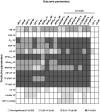Early reperfusion hemodynamics predict recovery in rat hearts: a potential approach towards evaluating cardiac grafts from non-heart-beating donors
- PMID: 22928009
- PMCID: PMC3424125
- DOI: 10.1371/journal.pone.0043642
Early reperfusion hemodynamics predict recovery in rat hearts: a potential approach towards evaluating cardiac grafts from non-heart-beating donors
Abstract
Aims: Cardiac grafts from non-heartbeating donors (NHBDs) could significantly increase organ availability and reduce waiting-list mortality. Reluctance to exploit hearts from NHBDs arises from obligatory delays in procurement leading to periods of warm ischemia and possible subsequent contractile dysfunction. Means for early prediction of graft suitability prior to transplantation are thus required for development of heart transplantation programs with NHBDs.
Methods and results: Hearts (n = 31) isolated from male Wistar rats were perfused with modified Krebs-Henseleit buffer aerobically for 20 min, followed by global, no-flow ischemia (32°C) for 30, 50, 55 or 60 min. Reperfusion was unloaded for 20 min, and then loaded, in working-mode, for 40 min. Left ventricular (LV) pressure was monitored using a micro-tip pressure catheter introduced via the mitral valve. Several hemodynamic parameters measured during early, unloaded reperfusion correlated significantly with LV work after 60 min reperfusion (p<0.001). Coronary flow and the production of lactate and lactate dehydrogenase (LDH) also correlated significantly with outcomes after 60 min reperfusion (p<0.05). Based on early reperfusion hemodynamic measures, a composite, weighted predictive parameter, incorporating heart rate (HR), developed pressure (DP) and end-diastolic pressure, was generated and evaluated against the HR-DP product after 60 min of reperfusion. Effective discriminating ability for this novel parameter was observed for four HR*DP cut-off values, particularly for ≥20 *10(3) mmHg*beats*min(-1) (p<0.01).
Conclusion: Upon reperfusion of a NHBD heart, early evaluation, at the time of organ procurement, of cardiac hemodynamic parameters, as well as easily accessible markers of metabolism and necrosis seem to accurately predict subsequent contractile recovery and could thus potentially be of use in guiding the decision of accepting the ischemic heart for transplantation.
Conflict of interest statement
Figures





References
-
- Manno EM (2005) Nonheart-beating donation in the neurologically devastated patient. Neurocrit Care 3: 111–114. - PubMed
-
- Doig CJ, Rocker G (2003) Retrieving organs from non-heart-beating organ donors: a review of medical and ethical issues. Can J Anaesth 50: 1069–1076. - PubMed
-
- Barnard CN (1967) The operation. A human cardiac transplant: an interim report of a successful operation performed at Groote Schuur Hospital, Cape Town. S Afr Med J 41: 1271–1274. - PubMed
-
- Boucek MM, Mashburn C, Dunn SM, Frizell R, Edwards L, et al. (2008) Pediatric heart transplantation after declaration of cardiocirculatory death. N Engl J Med 359: 709–714. - PubMed
-
- Ali A, White P, Dhital K, Ryan M, Tsui S, et al. (2009) Cardiac recovery in a human non-heart-beating donor after extracorporeal perfusion: source for human heart donation? J Heart Lung Transplant 28: 290–293. - PubMed
Publication types
MeSH terms
Substances
LinkOut - more resources
Full Text Sources
Other Literature Sources
Medical
Miscellaneous

